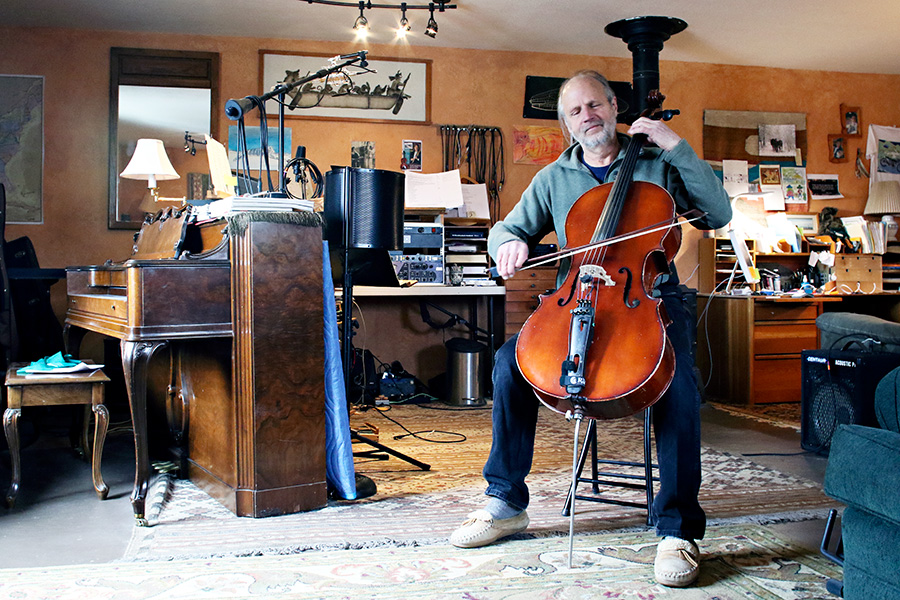Lee Zimmerman has trouble getting his portrait taken.
When he’s asked to hold his cello bow across the instrument for a composed shot, he does it, but then his eyes close seemingly of their own volition, his head bobs a bit, and the bow begins sliding across the strings. Were you to only see his face, you could think he was deep in meditation or prayer.
Opening his eyes again for the click of the camera, he laughs at himself.
“I can’t hold the bow on a cello and not play,” he says, by way of explanation for his little moment of Zen.
It’s been this way with the cello since Zimmerman, a fixture in the western Montana music scene for decades, was 7 years old, growing up in Billings. It was then, in his elementary school classroom, that members of the local symphony stopped by to show the kids what they do.
“After the end, I signed up to learn, got my little plywood cello,” Zimmerman said with a laugh.
It was the start of a lifelong love affair with the stringed instrument, known usually for its serious and emotional sounds in quartets and symphonies. In his capable hands, however, Zimmerman’s cellos emit staccato and rhythm found more in rock and roll.
He wakes up every morning to play the Bach Suites, but Zimmerman doesn’t consider himself a traditional cellist, but rather one out of his time.
“What I’ve always been is kind of an alt-cellist,” he said. “Rock and roll taught me.”
Zimmerman studied music in Missoula at the University of Montana for two years, but his progressive methods weren’t a welcome evolution quite yet. Some instructors were plainly offended with his new take on how to play, Zimmerman said, but it didn’t blunt his desire to discover more of what the cello could offer.
While he doesn’t regret his route to becoming a musician, he acknowledged how different it is now for young musicians experimenting with music.
“Today if I were a 20-year-old kid with the kind of brain that I have, I’d get into so many programs,” Zimmerman said.
As a young musician, Zimmerman cut his teeth playing in western Montana, but earned a living through carpentry, which he continued for 35 years. But like any true love story, Zimmerman and the cello had to go through a rough patch to know if the passion was real, if it was fate.
For 20 years, he didn’t pick up the instrument.
While working one day, Zimmerman caught his middle finger in a jointer; it pulled off the tip, and had there been a millimeter difference in the cut, he wouldn’t be playing today at all.
It was one of the fingers he used to push on the strings to create the right sound, and the bone was shorn to a point. He didn’t touch the instrument for years, but one day after walking out of a doctor’s appointment, he heard on the local radio station Stephane Grapelli’s Tribute to Django Reinhardt.
Reinhardt, one of the greatest musicians of the 20th century and one of the first major jazz talents to come from Europe, still managed to play his guitar despite a terrible burn injury that paralyzed two of his fingers.
“I thought, ‘OK I get it,'” Zimmerman said, upon hearing the tribute on the radio.
He decided to play the cello again; picking it up was like coming home.
“I was so astounded that I had quit,” he said.
The finger injury meant a permanent blood blister in the early days, and Zimmerman learned a new technique to save him some suffering. And while he relearned the instrument, his brain started churning again.
“I thought it would be cool to play and sing, because the two are a magic combination,” Zimmerman said. “At that same time a whole bunch of cellist singers emerged across the world. I just kept working on it and developing it.”
Eventually, he released an album, “Parallel Cats,” marrying cello and voice. His interests continued to evolve, and Zimmerman was able to use his woodworking skills to build his own unique travel cello. He also works as a luthier, fixing stringed instruments, and offers lessons.
“I still do carpentry work to keep my body and soul together,” Zimmerman said.
Current projects include transcribing tango music for the cello, and developing music for the Whitefish Theatre Company’s upcoming performance of “Gatsby.”
He invented a strap for his cello so he can play standing up, and he likes to work on dance projects. In many of those regards, he’s a man ahead of his time.
But he takes it in stride, always smiling, and ready to share the experience of the cello with anyone, anywhere.
Well, most anywhere.
“Cello just opens your heart,” Zimmerman said, laughing. “It’s almost dangerous to play in a bar.”
For more information on Lee Zimmerman, including upcoming local performances, visit www.leezimmerman.com. Also check out www.FlatheadEvents.net for daily updates on live music in the valley.
